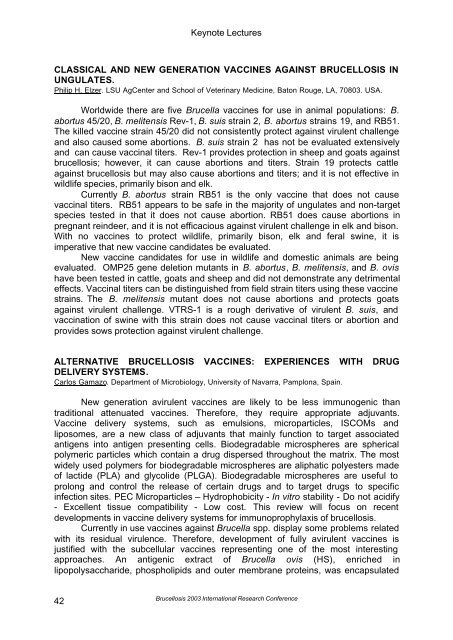Brucellosis 2003 proceedings - PHIDIAS
Brucellosis 2003 proceedings - PHIDIAS
Brucellosis 2003 proceedings - PHIDIAS
You also want an ePaper? Increase the reach of your titles
YUMPU automatically turns print PDFs into web optimized ePapers that Google loves.
Keynote Lectures<br />
CLASSICAL AND NEW GENERATION VACCINES AGAINST BRUCELLOSIS IN<br />
UNGULATES.<br />
Philip H. Elzer. LSU AgCenter and School of Veterinary Medicine, Baton Rouge, LA, 70803. USA.<br />
Worldwide there are five Brucella vaccines for use in animal populations: B.<br />
abortus 45/20, B. melitensis Rev-1, B. suis strain 2, B. abortus strains 19, and RB51.<br />
The killed vaccine strain 45/20 did not consistently protect against virulent challenge<br />
and also caused some abortions. B. suis strain 2 has not be evaluated extensively<br />
and can cause vaccinal titers. Rev-1 provides protection in sheep and goats against<br />
brucellosis; however, it can cause abortions and titers. Strain 19 protects cattle<br />
against brucellosis but may also cause abortions and titers; and it is not effective in<br />
wildlife species, primarily bison and elk.<br />
Currently B. abortus strain RB51 is the only vaccine that does not cause<br />
vaccinal titers. RB51 appears to be safe in the majority of ungulates and non-target<br />
species tested in that it does not cause abortion. RB51 does cause abortions in<br />
pregnant reindeer, and it is not efficacious against virulent challenge in elk and bison.<br />
With no vaccines to protect wildlife, primarily bison, elk and feral swine, it is<br />
imperative that new vaccine candidates be evaluated.<br />
New vaccine candidates for use in wildlife and domestic animals are being<br />
evaluated. OMP25 gene deletion mutants in B. abortus, B. melitensis, and B. ovis<br />
have been tested in cattle, goats and sheep and did not demonstrate any detrimental<br />
effects. Vaccinal titers can be distinguished from field strain titers using these vaccine<br />
strains. The B. melitensis mutant does not cause abortions and protects goats<br />
against virulent challenge. VTRS-1 is a rough derivative of virulent B. suis, and<br />
vaccination of swine with this strain does not cause vaccinal titers or abortion and<br />
provides sows protection against virulent challenge.<br />
ALTERNATIVE BRUCELLOSIS VACCINES: EXPERIENCES WITH DRUG<br />
DELIVERY SYSTEMS.<br />
Carlos Gamazo. Department of Microbiology, University of Navarra, Pamplona, Spain.<br />
New generation avirulent vaccines are likely to be less immunogenic than<br />
traditional attenuated vaccines. Therefore, they require appropriate adjuvants.<br />
Vaccine delivery systems, such as emulsions, microparticles, ISCOMs and<br />
liposomes, are a new class of adjuvants that mainly function to target associated<br />
antigens into antigen presenting cells. Biodegradable microspheres are spherical<br />
polymeric particles which contain a drug dispersed throughout the matrix. The most<br />
widely used polymers for biodegradable microspheres are aliphatic polyesters made<br />
of lactide (PLA) and glycolide (PLGA). Biodegradable microspheres are useful to<br />
prolong and control the release of certain drugs and to target drugs to specific<br />
infection sites. PEC Microparticles – Hydrophobicity - In vitro stability - Do not acidify<br />
- Excellent tissue compatibility - Low cost. This review will focus on recent<br />
developments in vaccine delivery systems for immunoprophylaxis of brucellosis.<br />
Currently in use vaccines against Brucella spp. display some problems related<br />
with its residual virulence. Therefore, development of fully avirulent vaccines is<br />
justified with the subcellular vaccines representing one of the most interesting<br />
approaches. An antigenic extract of Brucella ovis (HS), enriched in<br />
lipopolysaccharide, phospholipids and outer membrane proteins, was encapsulated<br />
42<br />
<strong>Brucellosis</strong> <strong>2003</strong> International Research Conference
















